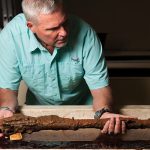
A new day for CCNC’s Dogwood Course
By Lee Pace
First impressions stick.
Robert “Ziggy” Zalzneck was a young accounting intern in Raleigh a long way from his Pennsylvania home during the holidays and was given access to the Country Club of North Carolina’s golf course on Christmas Day 1967. He had the place to himself. “I played 36 holes and it was 70 degrees,” Zalzneck says. “It was the prettiest place I’d ever been my whole life. I’ve loved the place ever since.”
Kris Spence was a young green superintendent at Greensboro Country Club in the mid-1980s when club staff and officers held a planning retreat at CCNC, the private, gated community nestled in the center of a triangle formed by Pinehurst, Southern Pines and Aberdeen.
“I’ll never forget coming onto the property the first time,” Spence remembers. “It was so impressive and set a standard you noticed quickly. It was a standard above even the best private clubs in the state.”
And Alex Bowness, a young homebuilder in Southern Pines, was invited to play the Ellis Maples-designed course in 1977 and knew immediately that he wanted to become a member.
“I’ll never forget playing the 15th hole the first time,” he says of the par-4 that kisses against the shore of Watson’s Lake — one of seven holes on the back nine accented by water. “It was April, the dogwoods were in bloom, and some dog ran across the fairway. It was a spellbinding vision. It took my breath away. I can see it today as if it were yesterday.”
Thirty-nine years later, Bowness is sitting in an Adirondack chair nestled in the pine forest between the fourth hole of the Dogwood golf course and his Williamsburg-style home. His cavalier king spaniel, O. Max, cavorts through the pine straw. It’s been home for Bowness and wife Susan since 2000.
“When we drive through the gate, our shoulders fall down,” he says. “It’s very relaxing. We live 2.4 miles from the gate, and it’s a nice, soft ride. From here we see golfers go by, we see little boats go by with fishermen. There’s even a bald eagle who lives near here; sometimes late in the day you’ll see him swoop through the trees. It’s almost like coming into a park.”
This “park” is now 53 years old, but it has a fresh coat of paint (and grass and sand and tree-scape) following a nine-month shutdown for Spence, now a golf course architect, to make significant changes to the course on agronomic, strategic and maintenance fronts. In nearly two decades of golf design, Spence has specialized in restoring and remodeling vintage courses by Golden Age architects like Donald Ross and then, from the next generation, Ellis Maples, the son of Ross’ green superintendent and construction foreman at Pinehurst, Frank Maples.
“Anyone who comes here has an expectation,” says Spence, who supervised the remodeling of the Dogwood course from November 2015 through Labor Day weekend of 2016. “It’s a lofty one. We can’t hit a triple here, we have to hit a grand slam. The expectation level is very high. The expectation was of excellence. When I came here to walk the course before the interview, it was anything but that. Time had just taken a toll on this golf course.”
While the Sandhills golf community had been built since the turn of the 20th century on resort golf and semi-private courses, a group of North Carolina businessmen believed in the early 1960s the state needed a private club centrally located that could draw members from Raleigh to Charlotte and beyond. Raleigh accountant Dick Urquhart, Greensboro investment banker Hargrove “Skipper” Bowles, Greensboro developer and builder Griswold Smith, and Raleigh attorney James Poyner were the four founding members and soon enticed three dozen “charter members” to join the club. They represented a Who’s Who of North Carolina business and philanthropy, among them C.C. Cameron of Raleigh, George Watts Carr of Durham, Frank Kenan of Durham, James Harris of Charlotte ,and Karl Hudson of Raleigh.
“What could be better than a good club centrally located for nearly all of us, ideally suited for golf, horses, hunting or just plain socializing?” Urquhart asked in a 1962 letter to charter members.
Willard Byrd studied landscape architecture at N.C. State in the late 1940s with an emphasis on land planning and had opened a shop in the land-planning business in Atlanta in 1956. He was hired to draw the master plan for CCNC, which would include approximately 300 residential lots averaging two acres apiece. The golf course was routed at the outset, with the lots to be arranged around the best land for golf. Much discussion ensued at the beginning over the issue of wrapping nine holes of golf around Watson’s Lake, thus eliminating some premier lakefront building lots.
At the time, Byrd was not officially a golf architect, so Maples was retained to collaborate on the creation of the golf course, to be named after the preponderance of dogwood trees on the property. The original plans have both the names of Byrd and Maples on the blueprint for each hole. Byrd created the routing and Maples designed the features — the green shapes and undulations, bunkers and placement of hazards.
“The course should be second to none from the very start,” said Urquhart, whose views that the golf course should get the premier lakefront exposure won out in that discussion.
The course opened in 1963 and was one of the original members of Golf Digest’s 100 Greatest Golf Courses and was site of the 1971 and 1972 Liggett & Myers Match Play Championship on the PGA Tour (won by Dewitt Weaver and Jack Nicklaus) and the 1980 U.S. Amateur (won by Hal Sutton). It has hosted six Southern Amateurs (with Ben Crenshaw and Webb Simpson among the winners), and the 110-year-old championship will return in 2017. It has been the venue for the 2010 U.S. Girls’ Junior Championship as well as multiple Carolinas Golf Association championships, including three Carolinas Amateurs and seven North Carolina Amateurs. The course remained in Digest’s rankings until 1999, when it was muscled out by the many outstanding new courses from the 1990s golf boom.
The original course was so popular the club built a second one and named it the Cardinal in keeping with the state of North Carolina theme. The course opened as 18 holes in 1981, a combination of nine holes each from Maples and Robert Trent Jones. The club converted those greens from bentgrass to Champion Bermuda in 2012 and liked the results, so a similar conversion was planned for the Dogwood, among other significant changes.
“We knew for five or six years we had a significant project ahead of us,” says Director of Golf Jeff Dotson. “The irrigation system was antiquated. The bunkers had reached the end of their useful life. It was a struggle every summer to keep the bent greens healthy, and the Bermuda greens on Cardinal were thriving.
“Dogwood had been one of the top courses in Southeast for half a century. We needed to set it up for the next 50 years.”
Much of the work was structural: convert the greens to Bermuda; install a new irrigation system; rebuild all the bunkers with the easier-to-maintain “Better Billy Bunker” system; replant the fairways with zoysia grass; open the vistas with the removal of several hundred trees that encroached over 50 years.
And much was strategic: bunkers repositioned to challenge more aggressive lines on dogleg holes; green approaches re-sculpted to allow run-up shots; a new green on the par-4 fourth built to reflect Maples’ original design that had never actually been built; a new green on the 15th hole positioned some 25 yards back from the original; a cross-bunker added in the landing area of the second shot on the par-5 18th, giving players more food for thought in planning their approach to the green.
“The structural issues have certainly been fixed,” Spence says. “Aesthetically and strategically, I think it reflects and respects Mr. Maples’ work. I wanted to respect his work but still adjust things to better suit the modern game. If you look through old photos of this course and others he designed, this still has that look and character of what I think he would approve of.”
Spence and Zalzneck were in the first foursome to play the remodeled course when it reopened on Sept. 2, Spence because he shepherded the work and Zalzneck because he’s now the club president.
“Kris was like a proud papa playing the course,” Zalzneck says. “And it was very rewarding for those of us who have worked on this project over three to four years. The changes reposition CCNC for a long time to come.”
And they preserve those first impressions that remain vivid in many minds despite the passage of time — not to mention creating new ones for residents like Alex and Susan Bowness from their Adirondack chairs along the fourth fairway. PS
Lee Pace has written about golf in the Sandhills since the late-1980s; his most recent book is The Golden Age of Pinehurst—The Story of the Rebirth of No. 2.





